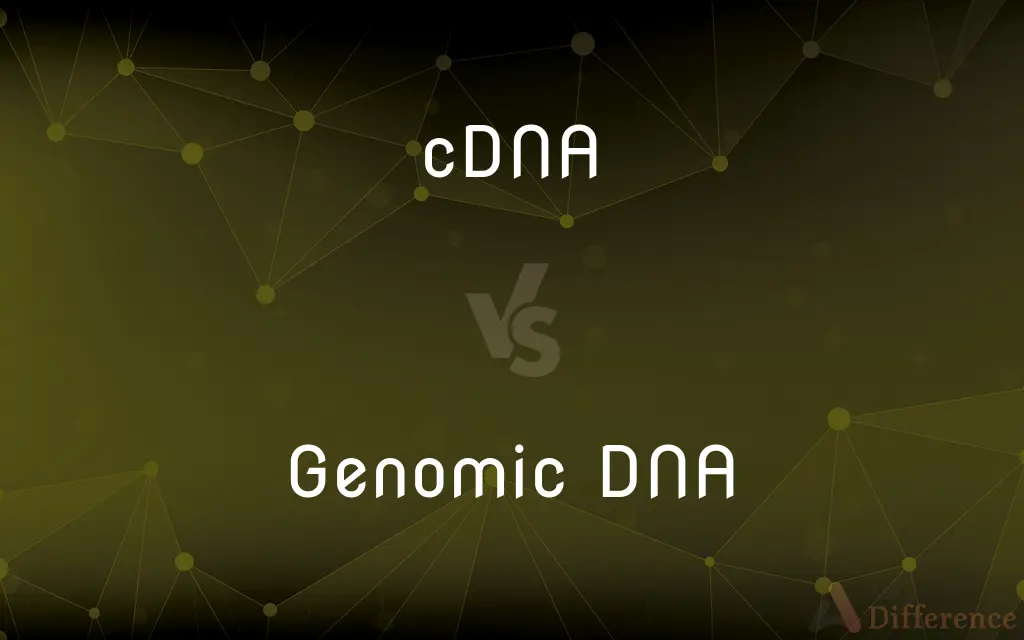cDNA vs. Genomic DNA — What's the Difference?
By Tayyaba Rehman — Published on December 2, 2023
cDNA is synthesized from mRNA and lacks introns. Genomic DNA contains all the genetic information of an organism, including both coding (exons) and non-coding (introns) regions.

Difference Between cDNA and Genomic DNA
Table of Contents
ADVERTISEMENT
Key Differences
cDNA, or complementary DNA, is synthesized from a messenger RNA (mRNA) template through the action of the enzyme reverse transcriptase. Genomic DNA, on the other hand, is the natural DNA that makes up the genome of an organism.
The most striking difference between cDNA and genomic DNA is their composition. While cDNA only represents the coding regions (exons) of genes as it's derived from mRNA, genomic DNA contains both coding (exons) and non-coding regions (introns).
In molecular biology, cDNA is often used in cloning and as a tool to analyze gene expression. Genomic DNA serves as the repository of an organism's genetic information and provides the blueprint for its biological functions.
cDNA lacks intronic sequences because the mRNA from which it is derived has already undergone the splicing process. Genomic DNA, in its entirety, has introns, exons, and other regulatory sequences.
In essence, while cDNA gives insight into the genes that are actively being expressed at any given time, genomic DNA provides a comprehensive view of an organism's genetic makeup, regardless of gene expression.
ADVERTISEMENT
Comparison Chart
Source
Derived from mRNA using reverse transcriptase.
Extracted directly from the cells of an organism.
Composition
Only exons (coding regions).
Exons, introns, and regulatory sequences.
Represents
Actively expressed genes.
Entire genetic makeup of an organism.
Usage
Cloning, analyzing gene expression.
Mapping, sequencing, and genetic studies.
Contains Introns
No.
Yes.
Compare with Definitions
cDNA
DNA synthesized from an mRNA template.
Researchers use cDNA libraries to study gene expression in specific tissues.
Genomic DNA
DNA containing both coding and non-coding regions.
Genomic DNA provides a comprehensive view of genetic information.
cDNA
A type of DNA lacking non-coding regions.
CDNA is valuable for studying expressed genes without intronic interference.
Genomic DNA
DNA found in the nucleus of eukaryotic cells.
Genomic DNA contains all the instructions needed for building and maintaining the organism.
cDNA
A complementary replication of mRNA in DNA form.
Through reverse transcription, mRNA is converted to cDNA.
Genomic DNA
The complete set of DNA in an organism.
Scientists sequenced the human genomic DNA to understand our genetic makeup.
cDNA
DNA representing only the genes being expressed at a particular time.
CDNA provides a snapshot of active gene expression in a cell.
Genomic DNA
The DNA representing an organism's entire genome.
Genomic DNA extraction is the first step in many genetic studies.
cDNA
The DNA equivalent of spliced mRNA.
CDNA cloning is a technique to capture expressed sequences of genes.
Genomic DNA
The hereditary material passed from one generation to the next.
Variations in genomic DNA can lead to different traits and diseases.
cDNA
Alternative form of cDNA
cDNA
Single-stranded DNA that is complementary to messenger RNA or DNA that has been synthesized from messenger RNA by reverse transcriptase
Common Curiosities
Does cDNA contain introns?
No, cDNA lacks introns as it's derived from spliced mRNA.
How does cDNA differ from genomic DNA?
cDNA only contains coding regions (exons), whereas genomic DNA contains both coding (exons) and non-coding regions (introns).
Can cDNA be used to study genetic mutations?
While cDNA can reveal mutations in exons, it won't show mutations in introns or regulatory regions; that requires genomic DNA.
What is cDNA?
cDNA is complementary DNA synthesized from an mRNA template using reverse transcriptase.
Is cDNA stable?
Yes, cDNA is stable and can be stored for future studies, unlike RNA which degrades more easily.
Why is cDNA important in research?
cDNA provides insight into genes that are actively expressed, making it valuable for studies on gene expression.
What is the primary source of genomic DNA?
Genomic DNA is extracted directly from the cells of an organism, representing its entire genetic content.
How is cDNA utilized in cloning?
cDNA is often used to clone expressed genes, enabling researchers to study their function.
Why doesn't cDNA contain regulatory sequences?
cDNA is derived from mRNA, which has already undergone processing to remove non-coding and regulatory sequences.
Can changes in genomic DNA affect an organism's traits?
Yes, mutations or changes in genomic DNA can lead to different traits or diseases in organisms.
What gives rise to cDNA?
cDNA is formed by reverse transcribing mRNA using the enzyme reverse transcriptase.
Can genomic DNA be used to determine gene expression levels?
No, gene expression is best analyzed using cDNA, as it represents actively expressed genes.
How do introns present in genomic DNA get removed in cDNA?
Introns are removed during RNA processing in the cell, so when mRNA is reverse transcribed to form cDNA, it lacks intronic sequences.
What's the significance of sequencing genomic DNA?
Sequencing genomic DNA allows researchers to understand an organism's entire genetic makeup and identify genetic variations.
Why might a scientist choose to work with cDNA rather than genomic DNA?
A scientist interested in studying gene expression or only the coding regions might prefer cDNA, as it lacks introns and non-coding sequences.
Share Your Discovery

Previous Comparison
Revenue Deficit vs. Fiscal Deficit
Next Comparison
Cerebrum Cortex vs. Cerebral CortexAuthor Spotlight
Written by
Tayyaba RehmanTayyaba Rehman is a distinguished writer, currently serving as a primary contributor to askdifference.com. As a researcher in semantics and etymology, Tayyaba's passion for the complexity of languages and their distinctions has found a perfect home on the platform. Tayyaba delves into the intricacies of language, distinguishing between commonly confused words and phrases, thereby providing clarity for readers worldwide.
















































